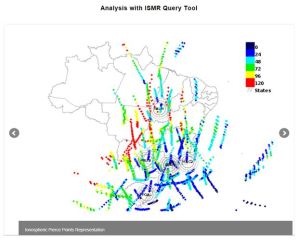Interference from the ionosphere can cause a significant error in GNSS observations. The impact of high solar activity and other disturbances in the ionosphere could potentially disable the use of GNSS and lead to low confidence in the use of GNSS for high accuracy applications.
Ionospheric scintillations are fluctuations in the phase and amplitude of the signals from GNSS satellites occurring when they cross regions of electron density irregularities in the ionosphere. Such disturbances can cause serious degradation on GNSS system performance, including integrity, accuracy and availability. At low latitudes scintillations occur very frequently due to ionospheric irregularities caused by high and inhomogeneous electron density.
Ionospheric disturbances mainly affect high and low latitude regions of the world and Brazil is particularly affected as it extends across the magnetic equator. Brazil is also a prominent market for high-accuracy GNSS applications.
Understanding and monitoring of scintillations are essential, so that warnings and forecast information can be made available to GNSS end users in order to guarantee the necessary levels of accuracy, integrity and availability of high precision and/or safety-of-life applications.
A network of Ionospheric Scintillation Monitor Receivers (ISMRs) was established in Brazil through the CIGALA (Concept for Ionospheric Scintillation Mitigation for Professional GNSS in Latin America) project and is now being extended in the CALIBRA (Countering GNSS high Accuracy applications Limitations due to Ionospheric disturbances in BRAzil) project. Both of these projects were funded by the European Commission under the Seventh Research Framework programme (FP7) and are managed by the European GNSS Agency (GSA).
The scintillation indices and a number of other parameters related to received GNSS signals are recorded for every satellite that the network tracks, generating more than ten million data items every day.
To enable analysis of this large amount of data, a web-based ISMR Query Tool has been developed using data visualization and data mining techniques. The capabilities of the tool include the analysis of the spatial and temporal behaviour of the scintillation phenomena, as well as their effects on GNSS positioning accuracy.
The understanding of the causes of ionospheric disturbances and modelling their effects will help on the development of new mitigation techniques and predictive models, as well as supporting research on ionospheric scintillation.
The ISMR tool was developed by the Faculty of Science and Technology at the Universida de Estadual Paulista (FCT/UNESP) in Brazil. The CALIBRA project is led by the Nottingham Geospatial Institute at the University of Nottingham in the UK and other partners are the National Institute of Geophysics and Volcanology in Rome, Italy, the University of Nova Gorica in Slovenia, the Septentrio Satellite Navigation, company from Belgium and the Brazilian company ConsultGEL. The CALIBRA project was launched in November 2012 and will last two years.

